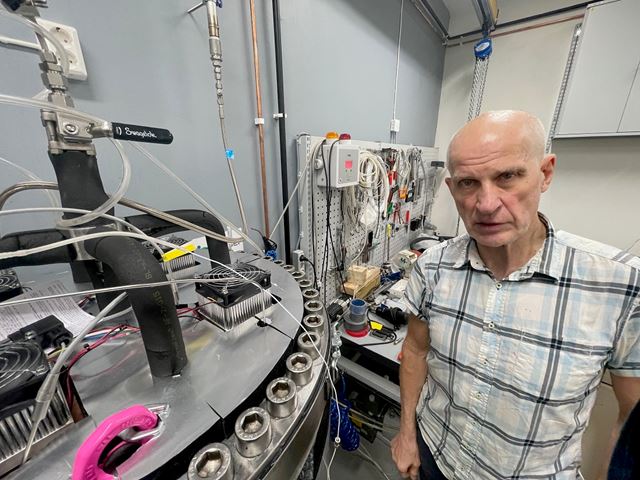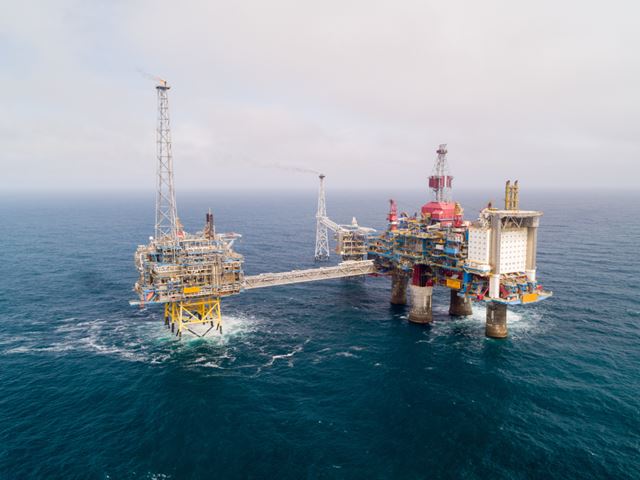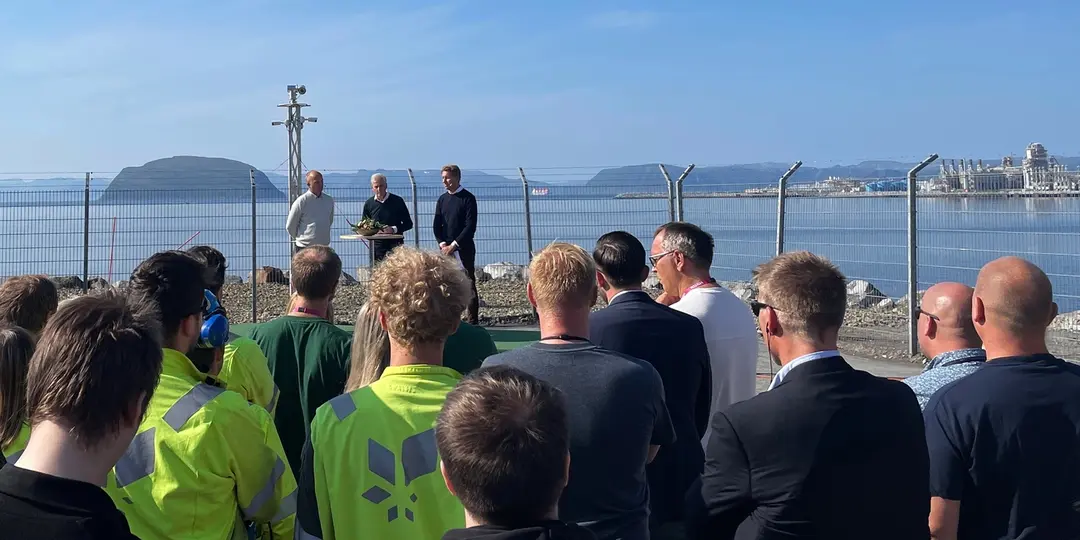It was the summer of 1986, and Erik Lindeberg, a research scientist in the oil reservoir division at SINTEF, invited his friend and colleague Torleif Holt to his cozy cabin on the shores of Lake Sommen in Sweden.
Like good research scientists everywhere, their conversations revolved around their current work – how to get as much petroleum out of oil reservoirs on the Norwegian Continental Shelf.
“The investments in North Sea were very high compared to onshore oil. So you really want to make most of it. And oil companies were not satisfied with getting 20 or 25% out of the reservoir, which was maybe a world average at that time. They wanted to use the long-term potential of the platforms and the infrastructure,” Lindeberg said.
Nevertheless, the two men were also concerned about the rising evidence showing that global warming was a real danger.
“We saw the conflict in extracting as much oil as possible in a world where accumulating CO2 in the atmosphere is actually a problem,” Lindeberg remembered.
But what if you could kill two birds with one stone? Oil companies in the US had long used CO2 to squeeze oil out of ageing oil reservoirs. Could Norway do the same? Then the CO2 would stay in the reservoir, reducing the carbon footprint of the extracted oil.

Senior researcher Erik Lindeberg back in the day, when he and his colleagues were figuring out how they could store unwanted CO2 in oil reservoirs. Photo: Morten Antonsen, SINTEF
There was just one problem: The US had coal fired power plants galore, all of which belched out CO2 like a crazy teenager after drinking a litre of very fizzy soda. With virtually all of its electricity generated by hydropower, Norway didn’t have a concentrated, point-source of CO2 like that.
So part of the challenge the two researchers faced was finding enough CO2 to make the whole process work.
- You might also like: The Longship that could help save the planet
Gas-fired power plants
It didn’t take long for the pair to come up with a solution: if there was a gas-fired power plant on an oil platform, or on a nearby ship, the gas could come from the platform and be used to make electricity that could be used transported to shore by an HVDC cable.
The CO2 could be captured from the power plant and then be injected into the oil reservoir to extract more oil.
“We used a generic oil field somewhere in the North Sea. We were going to produce power from gas at the platform, take out the CO2 and then inject it in oil reservoirs and transport the power to shore,” he said. “That was actually the first concept.”
At the time, oil prices were sky-high because of the Iran-Iraq war, which made the concept more appealing.
They got a small project grant from Statoil for their idea. In 1988, they published an internal SINTEF report: “Miljøvennlig gasskraft kombinert med økt oljeutvinning – en forstudie” (An environmentally friendly gas-fired power plant combined with enhanced oil recovery – a preliminary study).
However, they also found that the cost of removing the CO2 from a gas-fired power plant and using it to improve oil extraction was generally higher than the value of the extra oil that could be extracted. The idea was sound, but the price tag was a problem.
This, it would turn out, would be an enduring issue. It was partially addressed in 1991, with the introduction of a carbon tax, but the idea itself – that gas power plants could be made cleaner, by scrubbing the CO2 from their emissions – would be part of an off-and-on debate that continues today.

Erik Lindeberg continues to work as a researcher even though he is retired from SINTEF. Here, he’s standing next to what amounts to a giant pressure cooker, which he and his colleagues can use to simulate the enormous pressures that are found at the bottom of the sea. They use the tank to study the long-term behaviour of CO2 when it is stored in an undersea reservoir. Photo: Nancy Bazilchuk, NTNU
The Sleipner odyssey
It’s 1990, and Jens Stoltenberg is state secretary for the Environment Ministry under Torbjørn Berntsen. On a visit to SINTEF he became enthusiastic about the idea of clean gas power. He put together a project involving SINTEF – including Lindeberg, of course – along with Statoil, Saga, and Norsk Hydro to study CO2 injection on the continental shelf.
That helped set the stage for what would happen later at the Sleipner gas field.

The Sleipner field in the North Sea, where Equinor has been injecting CO2 into a subsea formation for nearly 30 years. Photo: Øyvind Gravås and Bo B. Randulff/©Equinor
The Sleipner field, first discovered in 1974, was rich with gas. But the gas contained 9 per cent CO2, which was far higher than acceptable for sale.
So, in 1992, when Statoil and its partners filed a development and operation plan for the field, they had to do something with the CO2. The Norwegian government limits the amount of CO2 in natural gas to 2.5 per cent. That, combined with the 1991 carbon tax, suddenly made carbon capture and storage at the Sleipner field seem very attractive.
And Lindeberg and his collaborators at SINTEF and Statoil had already laid the groundwork for doing exactly this. They had looked at CO2 injection on the Norwegian Continental Shelf, and knew it could actually work.
So when the Sleipner field began delivering gas in 1996, Statoil and its partners were able to capture and store 1 million tonnes of CO2 a year from the field. It was injected into a huge salty sand aquifer 1000 metres down, in a geologic formation called the Utsira formation.
Where the CO2 goes
From early on, Lindeberg has been interested in how much CO2 might escape from underground aquifers. That was useful information not only for Sleipner, but more generally, for the Norwegian Continental Shelf.

This illustration shows how natural gas containing CO2 (green) is extracted from a reservoir. After the CO2 is removed from the natural gas, the CO2 (blue) is reinjected into a different undersea reservoir called the Utsira Formation, at about 800 metres below the ocean bottom for long term storage. Illustration: Equinor
He and his colleagues naturally looked specifically at Sleipner, and how it was performing as the CO2 was injected into the sandstone reservoir over the years. Given that it was a long-running CCS project, Sleipner became a poster boy for how such a technology could work.
The researchers used time-lapse seismic to actually visualize how CO2 migrated through the Utsira formation. The results produced colourful diagrams of the way CO2 would migrate over the centuries through the giant formation. And it provided a window on how CO2 injection sites might be monitored in the future.
He and his colleagues also built a big stainless steel pressure tank to simulate the long term behavior of CO2 in a reservoir, where they observed that CO2-saturated water, which is denser than sea water, will slowly sink down through the formation. That creates circulation in the water, which can help the CO2 dissolve into the water. Dissolved CO2 can’t escape from an undersea reservoir in the same way that the injected CO2, which under pressure is liquid, could.
This mechanism “enhances the safety of the storage project,” he said. “It also helps us with data to simulate the long-term behaviour of the CO2.”
- You might also like: Norway should store Europe’s CO2
Finding leaks and dealing with them
Lindeberg acknowledges that these years of studies don’t provide an ironclad guarantee that there will be no leaks – but he is absolutely certain we have the technology to detect leaks and address them.
“In the industry we all talk about efficiency, and a hundred per cent efficiency in storage. I don’t believe in it,” he said. “If you drill thousands of wells, some of them will leak eventually. But that means just we have to increase our efforts. And if we reach 95% efficiency, that’s fine, 5% escapes into the ocean, we’ll be fine.”
In many ways, he said, the oil industry has paved the way for enabling CCS to work because it had to develop tools to understand how undersea oil formations behave and what happens when wells are drilled into them.
“We have seismic, resistance measurements, passive listening. So many of these tools have been developed for oil, and they can be fine tuned for this purpose,” to monitor CO2 storage sites, he said.
What to do about Melkøya?
Lindeberg argues that we can’t delay with CCS if we want to prevent the worst consequences from global warming. He’s not the only one who makes this argument – the IPCC, the Intergovernmental Panel on Climate Change, argues much the same thing.
And in the IEA’s Net Zero Emissions by 2050 (NZE) Scenario – which describes how the energy sector could meet the Paris Agreement goal of limiting global warming to 1.5 °C – around 1 billion tonnes of CO2 per year would have to be captured and stored by 2030.
So it might come as no surprise that in a recent debate over Equinor’s Melkøya LNG plant– which is responsible for roughly 2 per cent of Norway’s CO2 emissions – that Lindeberg argued for CCS.
He and the environmental group Bellona said that Equinor could reduce Melkøya’s carbon footprint by building a gas power plant to run the operation, capture the CO2 from that and inject it into seabed.
Equinor countered that the cost of doing so would be as much as NOK 6500 per tonne of CO2. The company calculated it would cost NOK 1700 per tonne if the plant was electrified.
Lindeberg, under the auspices of his consulting firm, CO2 Technology AS, calculated the CO2 could be captured and stored with a gas power plant for just over NOK 800 a tonne. Nevertheless, on 8 August 2023, the Norwegian government approved Equinor’s NOK 13.2 billion proposal to electrify Melkøya.

Press conference in Hammerfest on 8 August: Trygve Slagsvold Vedum (left), Minister of Finance, Jonas Gahr Støre, Prime Minister, and Terje Aasland, Minister of Petroleum and Energy. (Photo: Eva Sleire / Equinor)
How does Lindeberg feel about Equinor choosing not to pursue carbon capture and storage?
“It’s fine,” he says. “Actually, electrifying the oil industry was originally my idea, in 1990. Then the oil companies hated it – the NGOs loved it. Now it’s the other way around”
He’s also acutely aware of the urgency of needing to make cuts. Melkøya, he thinks, could have cut its CO2 emissions with a gas plant, yes, but in other cases, electrifying big sources of CO2 in Norway can make sense.
A technology optimist
“Electrification is the best way, the fastest way for Norway to meet its international commitments for reduction. Norway’s the slowest moving partner in Europe, much slower than the EU actually, to reduce their emissions. And if Norway is going to keep up with their commitments, then this is what they to have to do,” he said.
Lindeberg says Norway, as a rich country, has a responsibility to show that it’s possible to cut carbon emissions.
“If we can’t demonstrate for the world that rich countries can do it, why should China and Africa and South America, why should they? And so for Norway, it’s so important, and failure to meet our goal will be a political disaster,” he said.
Erik Lindeberg describes himself as a technology optimist. Even after four decades of seeing how hard it has been for CCS to put a dent in the world’s carbon emissions, he still thinks humankind will manage to get out of our global warming mess.
“It’s is a belief in the unlimited creativity of man that we can solve every problem, especially problems that we created ourselves,” he said. “I’m an optimist on behalf of CCS.”

